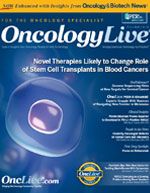Publication
Article
Oncology Live®
Pacritinib May Offer New Option for Tackling Myelofibrosis in Patients With Cytopenias
Author(s):
Pacritinib, a JAK2/FLT3 inhibitor, is among the most promising of those emerging options for patients with myelofibrosis.

James K. McCloskey II, MD
Hematologist/Oncologist
Division of Leukemia
John Theurer Cancer Center
Hackensack University Medical Center
Hackensack, NJ
Patients with myelofibrosis, a rare myeloproliferative neoplasm associated with a high mortality in intermediate- and high-risk disease states, have few options for treatment. Allogeneic stem cell transplantation is the only potentially curative option. Ruxolitinib is a JAK1/2 inhibitor that has been shown to improve quality of life and reduce spleen size, but it is associated with significant hematologic toxicity precluding its use in patients with significant thrombocytopenia.
Here at the John Theurer Cancer Center (JTCC), we treat a large number of patients with myelofibrosis. Although we perform allogeneic stem cell transplantation in appropriately selected patients, we are investigating new treatment options.
Pacritinib, a JAK2/FLT3 inhibitor, is among the most promising of those emerging options. The agent has significantly reduced spleen size and was associated with improved symptom control in early clinical trials. Treatment with pacritinib was associated with an improvement in platelet count and anemia among participants, with 25% of transfusion-dependent patients becoming transfusion independent.
The Myelofibrosis Landscape
Because of the rarity of the disease and lack of acceptable standard treatment, we encourage oncologists to reach out to experienced cancer centers early in the disease course to explore clinical trial options that aid in the development of novel therapies such as pacritinib. The PERSIST-2 study, currently enrolling patients at JTCC and more than 100 other locations in the United States and Europe, is one of the few randomized phase III studies focusing on patients with myelofibrosis and thrombocytopenia.Myelofibrosis is a primary bone marrow malignancy that belongs to the myeloproliferative neoplasm category. This heterogeneous group of diseases includes chronic myelogenous leukemia, essential thrombocythemia (ET), polycythemia vera (PV), systemic mastocytosis, chronic neutrophilic leukemia, and chronic eosinophilic leukemia. Patients may present with primary myelofibrosis (PMF) or may evolve to a myelofibrotic state from preexisting ET or PV.
Both primary and secondary myelofibrosis share a similar pathophysiology. Initial stages of the disease are characterized by aberrant clonal stem cell proliferation with increased CD34-positive cells in the marrow and abnormal cytokine expression. This results in reactive bone marrow fibrosis and worsening anemia and thrombocytopenia. In later forms of the disease, patients exhibit significant hepatosplenomegaly as these organs become sites for hematopoiesis.1
The clinical manifestations of myelofibrosis include constitutional symptoms, splenomegaly, anemia, thrombocytopenia, bone pain, pruritus, and splenic infarct. Severe fatigue, bone pain, and gastrointestinal symptoms related to splenomegaly can dramatically impact the quality of life for patients with myelofibrosis.1 This burden is often compounded by comorbid conditions and advanced age. Many patients will die from the disease, and approximately 20% eventually evolving to acute leukemia.2
Role of JAK2/STAT Signaling
Multiple prognostic models exist for risk stratification at the time of diagnosis (IPSS), after diagnosis (DIPSS), and based on molecular and cytogenetic features (DIPSS-plus). Age greater than 65 years, hemoglobin >10 g/dL, leukocyte count >25,000/μL, platelet count <100,000/μL, circulating blasts ≥1%, constitutional symptoms, and high-risk cytogenetics, are associated with inferior outcome.3-5 More recently, mutations in ASXL1 have also been linked with poor clinical outcome.6,7Myelofibrosis has been closely linked to dysregulation of the JAK2/STAT pathway. Mutations in JAK2 V617F, exon 9 of calreticulin (CALR), and exon 10 of the thrombopoetin receptor gene (MPL) all lead to dysregulation of the JAK2/ STAT pathway and are observed in 58%, 25%, and 8% of PMF patients, respectively.8 JAK2 is an intracellular tyrosine kinase that regulates the STAT pathway. The STAT pathway is responsible for regulating crucial aspects of hematopoiesis.9 The JAK2 V617F mutation results in impaired auto-inhibition of JAK2, resulting in constitutive activation of the JAK2 cascade.10
In addition to aiding in diagnosis, these molecular phenotypes have been observed to have some prognostic value. Patients with mutated CALR as the only abnormality have a more indolent course. The 9% of patients with a triple- negative phenotype have a poor prognosis. 8 The discovery of the role of JAK2 signaling in PMF, ET, and PV led to the synthesis of molecules targeting the JAK2 receptor. Ruxolitinib is a JAK1/2 inhibitor that was studied in two randomized phase III clinical trials, COMFORT-I and COMFORT-II. Both trials showed that ruxolitinib decreased spleen size and constitutional symptoms, and was associated with an improved quality of life. These benefits were seen irrespective of the JAK2 mutational status. Neither study demonstrated a significant survival benefit.
Pacritinib Data Promising
Ruxolitinib was generally well tolerated but associated with anemia (90%) and thrombocytopenia (70%). The anemia associated with ruxolitinib was worse during the first 2 months of therapy with an overall improvement thereafter. Thrombocytopenia did not improve and as a result, ruxolitinib dosing needs to be reduced in patients with platelet counts <200,000/μL and must be withheld for patients with platelet counts <50,000/μL.11, 12Pacritinib, formerly called SB1518, is a novel inhibitor of JAK2 and FLT3. Unlike ruxolitinib, it has no JAK1 activity. In preclinical studies, it exhibited potent JAK2 inhibition independent of mutational status.13
Table. Reduction in Spleen Volumea With Pacritinib Versus Best Available Therapy, According to Baseline Cytopenia Level14
BAT indicates best available therapy; ITT, intent to treat.
aSpleen volume reduction defined as ≥35% from baseline to week 24.
bITT population indicates primary analysis included all patients randomized. Patients who missed MRI or CT scans at baseline or at week 24 were counted as nonresponders.
cEvaluable population analysis included patients who had assessment at both baseline and at week 24.
Early clinical trials showed promising results in patients with myeloid malignancies including PMF. The results of the phase III PERSIST-1 trial were presented by Ruben A. Mesa, MD, at the 2015 ASCO Annual Meeting in June.14 In this study, 327 patients with PMF, post-PV myelofibrosis, or post-ET myelofibrosis were randomized in a 2:1 fashion to pacritinib versus best available therapy (BAT). Patients previously treated with ruxolitinib were excluded. Best standard of care options included erythropoietin- stimulating agents, immunomodulatory drugs such as thalidomide and lenalidomide, and hydroxyurea. The primary endpoint was the proportion of patients achieving ≥ 35% spleen volume reduction (SVR) at week 24.14 Of the 327 patients enrolled, 220 were randomized to the pacritinib arm and 107 to BAT.
Median time to diagnosis was 1.12 years. Patients with thrombocytopenia were not excluded; 32% and 15% of patients had platelet counts of <100,000/μL or <50,000/ μL, respectively. A significant proportion (75%) were JAK2 V617F— positive. The median duration of treatment was 16.2 months on pacritinib versus 5.9 months on BAT. The SVR rates at week 24 were 19.1% for pacrtinib versus 4.7% for BAT (P = .0003) in the intent-to-treat population and 25% versus 5.9% (P = .0001) in the evaluable population (Table). Subgroup analysis showed that patients with significant thrombocytopenia also experienced SVR. In fact, the greatest difference in the treatment arms was observed in evaluable patients with the lowest platelet counts. In patients with <50,000/μL platelets, 33.3 % versus 0% met the primary endpoint (P = .037). These patients also experienced a 35% increase in platelet counts from baseline compared with BAT (35%; P = .003). In the subgroup of red blood cell—dependent patients, 25.7% of patients receiving pacritinib became transfusion independent. None of the BAT patients experienced this benefit.
As seen in phase II studies, the most common grade 3 serious adverse events were diarrhea, nausea, and vomiting. Hematologic adverse events were uncommon. Despite some reported gastrointestinal toxicities, patients treated with pacritinib experienced a significant improvement in symptoms. Patients on study completed a daily electronic diary of symptoms including the Myeloproliferative Neoplasm Symptom Assessment Form. Patients treated with pacritinib experienced greater improvement in their symptoms when compared with BAT (40.9% vs 9.9% among evaluable patients, P <.0001).14 As a result of these findings, the PERSIST-2 study has been launched.15 The trial is enrolling patients with platelet counts ≤100,000/ μL. The primary objective of PERSIST-2 is to compare the efficacy of two dose-schedule arms of pacritinib with that of BAT in this patient population.
The efficacy co-endpoints consist of the proportion of patients achieving a ≥35% reduction in spleen volume from baseline to week 24 (measured by MRI or CT) and the proportion of patients achieving a ≥50% reduction in total symptom score from baseline to week 24. Patients are randomized 1:1:1 to one of three treatment arms including pacritinib 400 mg orally daily, pacritinib 200 orally twice daily, and BAT.
References
- Tefferi A. Pathogenesis of myelofibrosis with myeloid metaplasia. J Clin Oncol. 2005;23(33):8520—8530.
- Mesa RA, Li CY, Ketterling RP, et al. Leukemic transformation in myelofibrosis with myeloid metaplasia: a single-institution experience with 91 cases. Blood. 2005;105(3):973—977.
- Cervantes F, Dupriez B, Pereira A, et al. New prognostic scoring system for primary myelofibrosis based on a study of the International Working Group for Myelofibrosis Research and Treatment. Blood. 2009;113(13):2895—2901.
- Passamonti F, Cervantes F, Vannucchi AM, et al. A dynamic prognostic model to predict survival in primary myelofibrosis: a study by the IWG-MRT (International Working Group for Myeloproliferative Neoplasms Research and Treatment). Blood. 2010;115(9):1703-1708.
- Gangat N, Caramazza D, Vaidya R, et al. DIPSS plus: a refined Dynamic International Prognostic Scoring System for primary myelofibrosis that incorporates prognostic information from karyotype, platelet count, and transfusion status. J Clin Oncol. 2011;29(4):392—397.
- Tefferi A, Guglielmelli P, Lasho TL, et al. CALR and ASXL1 mutations- based molecular prognostication in primary myelofibrosis: an international study of 570 patients. Leukemia. 2014;28(7):1494-1500.
- Guglielmelli P, Lasho TL, Rotunno G, et al. The number of prognostically detrimental mutations and prognosis in primary myelofibrosis: an international study of 797 patients. Leukemia. 2014;28(9):1804-1810.
- Tefferi A, Lasho TL, Finke CM, et al. CALR vs JAK2 vs MPL-mutated or triple-negative myelofibrosis: clinical, cytogenetic and molecular comparisons. Leukemia. 2014;28(7):1472-1477.
- Dawson MA, Bannister AJ, Göttgens B, et al. JAK2 phosphorylates histone H3Y41 and excludes HP1alpha from chromatin. Nature. 2009;461(7265):819-822.
- Vainchenker W, Constantinescu S. JAK/STAT signaling in hematological malignancies. Oncogene. 2013;32(21): 2601-2613.
- Verstovsek S, Mesa RA, Gotlib J, et al. A double-blind, placebo- controlled trial of ruxolitinib for myelofibrosis. N Engl J Med. 2012;366(9):799—807.
- Harrison C, Kiladjian JJ, Al-Ali HK, et al. JAK inhibition with ruxolitinib versus best available therapy for myelofibrosis. N Engl J Med. 2012;366(9):787—798.
- William AD, Lee AC, Blanchard S, et al. Discovery of the macrocycle 11-(2-pyrrolidin-1-yl-ethoxy)-14,19-dioxa-5,7,26-triaza-tetracyclo[ 19.3.1.1(2,6).1(8,12)]heptacosa-1(25),2(26),3,5,8,10,12(27),16,21, 23-decaene (SB1518), a potent Janus kinase 2/fms-like tyrosine kinase-3 (JAK2/FLT3) inhibitor for the treatment of myelofibrosis and lymphoma. J Med Chem. 2011;54(13): 4638—4658.
- Mesa RA, Egyed M, Szoke A, et al. Results of the PERSIST-1 phase III study of pacritinib (PAC) versus best available therapy (BAT) in primary myelofibrosis (PMF), post-polycythemia vera myelofibrosis (PPV-MF), or post-essential thrombocythemia-myelofibrosis (PETMF). J Clin Oncol. 2015;33(suppl; abstr LBA7006).
- NIH Clinical Trials Registry. www.ClinicalTrials.gov website. Identifier: NCT02055781.










